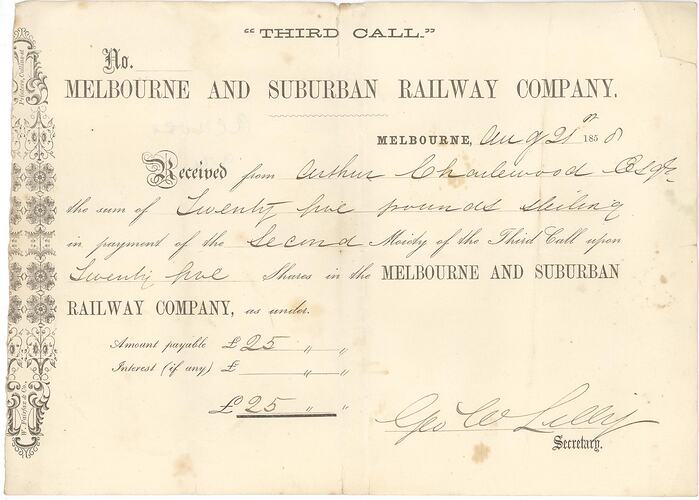Summary
Share receipt for the Melbourne & Suburban Railway Company, August 21st, 1858 (?), Issued to Arthur Charlewood, for twenty five pounds on payment of the second moeity of the third call upon twenty-five shares. Signed by Geo. W. Lilly. Priinted by W. Fairfax & Co, Printers, Collins Street.
The Melbourne & Suburban Railway Company was originally formed in June 1857 to build Melbourne's first suburban railways to Hawthorn and Brighton, capitalising on the success of the Melbourne & Hobsons Bay Railway Co. which had successfully opened Australia's first steam railway between Flinders Street and Port Melbourne (then Sandridge) on 12 September, 1854. Based on plans prepared by the prominent Melbourne engineer, A.K. Smith, the company received parliamentary authorisation in November 1857 and began construction of two lines from a new terminal station at Princes Bridge (opposite Flinders Street Station). Their routes required the construction of two massive iron bridges across the Yarra River at Cremorne and Hawthorn, the cost of which were to cripple the company, which was undercapitalised from the start. Services opened as far as Chapel Street (now Windsor Station) in December 1860 and to Hawthorn in April 1861, but construction costs had totalled £475,000 and the company failed to operate at a profit. In 1865, it merged with the Hobsons Bay Railway Co. to form the Melbourne & Hobson's Bay United Railway Co., which did operate profitably but was subsequently acquired by the government owned Victorian Railways in 1878.
One of the problems that contributed to the demise of the Melbourne & Suburban Railway Company was that it effectively was competing directly with the rival St Kilda & Brighton Railway Co., also formed in June 1857, with plans to build a much lower cost railway to Brighton from the St Kilda terminus of the Melbourne & Hobsons Bay Railway Company. The line which crossed St Kilda Road on a long timber viaduct, opened on 19 December 1859, using borrowed locomotives and rollingstock. It too failed to make a profit, with operations being taken over by the Melbourne & Suburban Railway Co. in May 1862, and the assets being purchased by the Melbourne & Hobsons Bay United Railway Co. in September 1865.
Obverse Description
Printed and handwritten on in black ink on off-white stock. Headed "Third Call". Decorative cartouche on one side.
Significance
The Melbourne & Suburban Railway Company was formed in June 1857 to construct railway lines from Princes Bridge Station, Melbourne, to Hawthorn and Brighton, and incorporated by Act of Parliament the following November, with an authorised capital of £300,000 in 30,000 shares of £10 each. Hampered by undercapitalisation, competition from the St Kilda & Brighton Railway Co (which shared part of its southern route) and technical difficulties in constructing two major bridges across the Yarra River at Hawthorn and Cremorne, the company struggled to achieve its ambitious plans, opening limited services to Richmond in December 1859, with extensions to Windsor and Hawthorn operating by April 1861. With capital subscriptions of only £250,000 and construction costs amounting to £475,000, the company was soon forced into liquidation and reformed as the Melbourne Railway Co in March 1862, before later being absorbed by the Melbourne & Hobsons Bay United Railway Co in 1865. This evocatively illustrated share scrip reflects the rush of speculative private railway investment that swept Victoria in the five years following the successful opening of Australia's first steam-powered public railway from Melbourne to Sandridge (now Port Melbourne) by the Melbourne and Hobsons Bay Railway Company in September 1854. Despite its lack of financial success the company created a key part of Melbourne's public transport infrastructure which remains in use today and made a significant contribution to suburban grow to the south and east of the Yarra River during the decades following the 1850s goldrushes.
More Information
-
Collection Names
-
Collecting Areas
-
Acquisition Information
Purchase
-
Date Issued
1858 AD
-
Issued By
Melbourne & Suburban Railway Company, Melbourne, Greater Melbourne, Victoria, Australia, 1858
-
Material
Paper
-
Classification
Rail transport, Railway infrastructure - permanent way, Share scrip
-
Category
-
Discipline
-
Type of item
-
Overall Dimensions
233 mm (Width), 162 mm (Height)
-
Shape
Rectangle
-
Keywords

